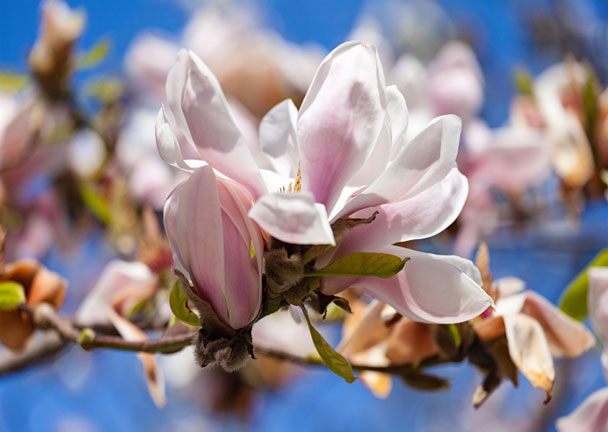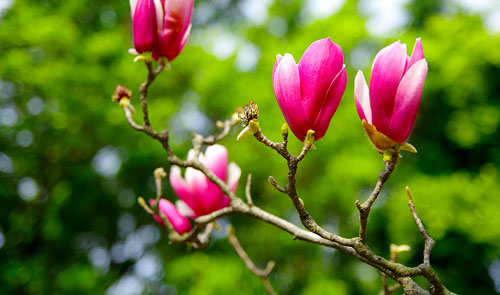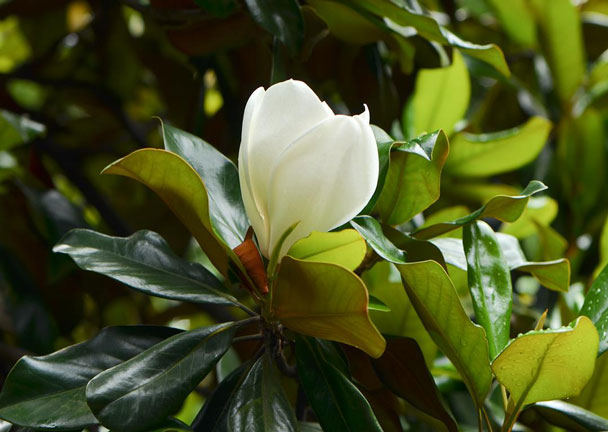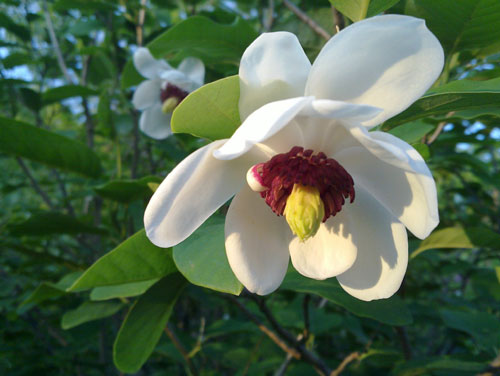Magnolia Tree Grow & Care Guide
Written by Iris
Oct 13 2021

Magnolia is a small deciduous tree. It grows to a height of about five meters. It has a unique woody aroma. The flowers are mostly yellow-green with purple on the outside and almost white on the inside. The fruit is rectangular in shape. A characteristic plant with particularly strong cold tolerance.


Otherwise, there will be no negative health effects. In nature, this is an understory tree and it normally gets dappled sunlight. When it gets an abundance of light it really excels.
Most magnolias will thrive on a neutral or slightly acid soil, with a pH of around 5.5 – 6.5. Chalky soils can be trickier, but some species such as Magnolia stellata and magnolia soulangeana will cope nicely, making a worthwhile display.
Established Magnolia plants can benefit from fertilization.Take a visual inventory of your landscape. Trees need to be fertilized every few years. Shrubs and other plants in the landscape can be fertilized yearly. A soil test can determine existing nutrient levels in the soil. If one or more nutrients is low, a specific instead of an all-purpose fertilizer may be required. Fertilizers that are high in N, nitrogen, will promote green leafy growth. Excess nitrogen in the soil can cause excessive vegetative growth on plants at the expense of flower bud development. It is best to avoid fertilizing late in the growing season. Applications made at that time can force lush, vegetative growth that will not have a chance to harden off before the onset of cold weather.
However, if you still wish to reduce, balance or remodel the branches, to save garden space for example, you may do so just after flowering, or in autumn.
Scales are insects, related to mealy bugs, that can be a problem on a wide variety of plants - indoor and outdoor. Young scales crawl until they find a good feeding site. The adult females then lose their legs and remain on a spot protected by its hard shell layer. They appear as bumps, often on the lower sides of leaves. They have piercing mouth parts that suck the sap out of plant tissue. Scales can weaken a plant leading to yellow foliage and leaf drop. They also produce a sweet substance called honeydew (coveted by ants) which can lead to an unattractive black surface fungal growth called sooty mold.
Prevention and Control: Once established they are hard to control. Isolate infested plants away from those that are not infested. Consult your local garden center professional or Cooperative Extension office in your county for a legal recommendation regarding their control. Encourage natural enemies such as parasitic wasps in the garden.
Diseases: Blight
Blights are cause by fungi or bacteria that kill plant tissue. Symptoms often show up as the rapid spotting or wilting of foliage. There are many different blights, specific to various plants, each requiring a varied method of control.
Dwarf Magnolia (M. grandiflora ‘Little Gem’)
‘Little Gem’ Magnolia is an evergreen variety that can grow to about 4 metres tall. It has white creamy flowers that appear in the spring and summer and lovely deep green leaves with bronze colouring on the underside.
‘Teddy Bear’ Magnolia (M. grandiflora ‘Teddy Bear’)
Very popular tree for the home garden. Leaves are similar to that of the ‘Little Gem’ Magnolia but it can grow to about 6 metres. Flowers appear in summer.
Port Wine Magnolia (M. figo, syn. michelia figo)
Evergreen shrub that grows to around 3 metres tall. Leaves on this tree are small and light green, with small pinky-white flowers that have a scent reminiscent of bubble gum that appear from September to November. These plants can be kept trimmed back and hedged or shaped into balls.
Yulan Magnolia (M. denudata)
Small decidious tree that can grow to 5 metres tall. In Spring they produce a lovely large white flower that stands out on their bare branches.
Where to Grow Magnolia TreeWhen to Grow Magnolia TreeHow to Grow Magnolia TreeMagnolia Tree Propagation with Stem CuttingsMagnolia Tree Propagation with Air layeringHow to Care for Magnolia TreeMagnolia Tree Lighting RequirementsMagnolia Tree Soil CareMagnolia Tree WateringMagnolia Tree Temperature & HumidityMagnolia Tree FertilizerMagnolia Tree PruningMagnolia Tree Pests & Diseases CareVarieties of Magnolia
Where to Grow Magnolia Tree
Like any early flowering plant, there is a risk that frost may damage the blooms. This risk can be minimised by growing Magnolia Tree in a sunny or semi shaded spot, with protection from strong winds and hard spring frosts. In cold areas and frost pockets, choose a variety that will flower later in the spring when most frosts have passed. Be sure to give them sufficient space to reach their full potential. Plants that must compete for light and space will never truly thrive. Some varieties of Magnolia are small enough to be grown as a container plant.
When to Grow Magnolia Tree
Deciduous magnolias (those that drop their leaves in fall) are best planted when dormant, typically in late fall or winter in warmer climates and early spring in cold climates. Evergreen magnolias are best planted in early spring. For the first 6 to 12 months after planting, both types will benefit from mulch and regular irrigation during warm or dry weather.How to Grow Magnolia Tree
Starting a magnolia tree from cuttings produces trees much faster than seedlings. Two years after you root a magnolia cutting, you may get flowers, while with a seedling, you can wait over a decade. But starting a magnolia tree from cuttings is not a sure bet. A large percentage of the cuttings fail. Put luck on your side by following the tips below.Magnolia Tree Propagation with Stem Cuttings
The first step in propagating magnolia trees from cuttings is to take cuttings in the summer after the buds set. Using a knife or pruner sterilized in denatured alcohol, cut 6- to 8-inch (15-20 cm.) growing tips of branches as cuttings. Place the cuttings in water as you take them. When you get all you need, remove all but the upper leaves of each cutting, then make a 2-inch (5 cm.) vertical slice in the stem end. Dip each stem end in a good hormone solution, and plant in small planters filled with moist perlite. Position the planters in indirect light, and tent each one with a plastic bag to keep in humidity. Mist them often, and watch for root growth in a few months.Magnolia Tree Propagation with Air layering
Air layering is another method of propagating magnolia trees. It involves wounding a living branch, then surrounding the wound with moist growing medium until roots form. To accomplish magnolia air layering, try it in early spring on one-year-old branches or in late summer on that season’s growth. Make parallel cuts circling the branch about 1½ inches apart (1.27 cm.), then join the two lines with another cut and remove the bark. Place damp sphagnum moss around the wound and tie it in place by wrapping with twine. Secure a sheet of polyethylene film around the moss and secure both ends with electrician tape. Once the air layering is put in place, you need to keep the medium damp all the time, so check frequently. When you see roots protruding from the moss on all sides, you can separate the cutting from the parent plant and transplant it.
How to Care for Magnolia Tree
Magnolia Tree Lighting Requirements
Light is not a major concern to the health of the Ashe's magnolia and will only effect blooms and form. Without full sun, the form of the tree will be spindly and have intermittent blooms. The limbs are heliotropic, the plant moves towards the sun, and its form will be affected greatly by that.Otherwise, there will be no negative health effects. In nature, this is an understory tree and it normally gets dappled sunlight. When it gets an abundance of light it really excels.
Magnolia Tree Soil Care
Magnolias prefer a moist, well-drained soil which is rich in organic matter, so it is well worth adding some well-rotted manure or compost to the planting hole, mixing it thoroughly and deeply.Most magnolias will thrive on a neutral or slightly acid soil, with a pH of around 5.5 – 6.5. Chalky soils can be trickier, but some species such as Magnolia stellata and magnolia soulangeana will cope nicely, making a worthwhile display.
Magnolia Tree Watering
Most varieties tolerate hot summers and some drought. But younger trees will need to be watered regularly for two years until they’re established. Drip irrigation is your friend.Magnolia Tree Temperature & Humidity
The Ashe's magnolia is adaptable to a range of climates but does not do well in hot and dry conditions.Magnolia Tree Fertilizer
Young plants need extra phosphorus to encourage good root development. Apply recommended amount for plant per label directions in the soil at time of planting or at least during the first growing season.Established Magnolia plants can benefit from fertilization.Take a visual inventory of your landscape. Trees need to be fertilized every few years. Shrubs and other plants in the landscape can be fertilized yearly. A soil test can determine existing nutrient levels in the soil. If one or more nutrients is low, a specific instead of an all-purpose fertilizer may be required. Fertilizers that are high in N, nitrogen, will promote green leafy growth. Excess nitrogen in the soil can cause excessive vegetative growth on plants at the expense of flower bud development. It is best to avoid fertilizing late in the growing season. Applications made at that time can force lush, vegetative growth that will not have a chance to harden off before the onset of cold weather.
Magnolia Tree Pruning
Magnolia's most defining characteristic is it's natural shape. It's important to maintain this shape without unbalancing the branches. Because of this, pruning is theoretically unnecessary.However, if you still wish to reduce, balance or remodel the branches, to save garden space for example, you may do so just after flowering, or in autumn.
Magnolia Tree Pests & Diseases Care
Pest: Scale InsectsScales are insects, related to mealy bugs, that can be a problem on a wide variety of plants - indoor and outdoor. Young scales crawl until they find a good feeding site. The adult females then lose their legs and remain on a spot protected by its hard shell layer. They appear as bumps, often on the lower sides of leaves. They have piercing mouth parts that suck the sap out of plant tissue. Scales can weaken a plant leading to yellow foliage and leaf drop. They also produce a sweet substance called honeydew (coveted by ants) which can lead to an unattractive black surface fungal growth called sooty mold.
Prevention and Control: Once established they are hard to control. Isolate infested plants away from those that are not infested. Consult your local garden center professional or Cooperative Extension office in your county for a legal recommendation regarding their control. Encourage natural enemies such as parasitic wasps in the garden.
Diseases: Blight
Blights are cause by fungi or bacteria that kill plant tissue. Symptoms often show up as the rapid spotting or wilting of foliage. There are many different blights, specific to various plants, each requiring a varied method of control.

Varieties of Magnolia
Large evergreen tree that can grow up to 20 metres in height. Best grown in large areas as its ultimate size and form is similar to that of a Moreton Bay Fig tree. Not recommended for the home garden.Dwarf Magnolia (M. grandiflora ‘Little Gem’)
‘Little Gem’ Magnolia is an evergreen variety that can grow to about 4 metres tall. It has white creamy flowers that appear in the spring and summer and lovely deep green leaves with bronze colouring on the underside.
‘Teddy Bear’ Magnolia (M. grandiflora ‘Teddy Bear’)
Very popular tree for the home garden. Leaves are similar to that of the ‘Little Gem’ Magnolia but it can grow to about 6 metres. Flowers appear in summer.
Port Wine Magnolia (M. figo, syn. michelia figo)
Evergreen shrub that grows to around 3 metres tall. Leaves on this tree are small and light green, with small pinky-white flowers that have a scent reminiscent of bubble gum that appear from September to November. These plants can be kept trimmed back and hedged or shaped into balls.
Yulan Magnolia (M. denudata)
Small decidious tree that can grow to 5 metres tall. In Spring they produce a lovely large white flower that stands out on their bare branches.
Latest Updated
- Benefits of Bugleweed - 7 Science-backed Health Benefits
- Bugleweed Dangers & Side Effects - Is It Poisonous?
- How to Plant Evergreen Trees - What You Should Know
- When to Plant Evergreens - Grow Guide for Evergreen Trees
- 12 Wonderful Evergreen Shrubs for Your Garden
- 12 Popular Evergreen Plants with Pictures for Beginners
- When And How To Prune A Lilac Bush Like a Pro
- How to Grow & Care for Lilac Vine (Hardenbergia Violacea)
- Japanese Lilac Tree (Syringa Reticulata) Care & Propagation Guide
- Shumard Oak Pros and Cons - What to Know
Popular Articles
- Winter maintenance of Antirrhinum Majus
- How to Grow Terminalia Mantaly Tree
- How to Grow and Care for Crossostephium Chinense
- How to grow Antirrhinum Majus in spring
- Peristeria Elata (Dove Orchid) Profile: Info & Care Guide
- Underwatered Snake Plant (Sansevieria Trifasciata) - Signs And How To Fix
- How to Care for Brazilian Jasmine Plant (Mandevilla Sanderi)
- How to Grow & Care for Graptopetalum Purple Delight in Summer
- Rosa Chinensis (China Rose): Plant Growing & Care Tips
- How to Care for Baby Sun Rose (Aptenia Cordifolia)